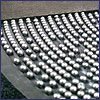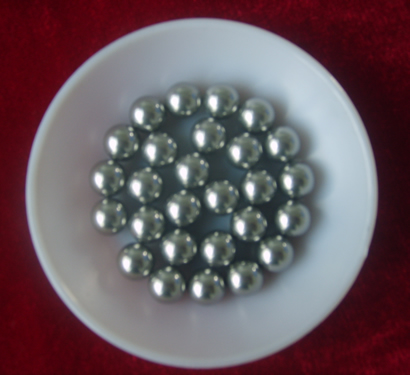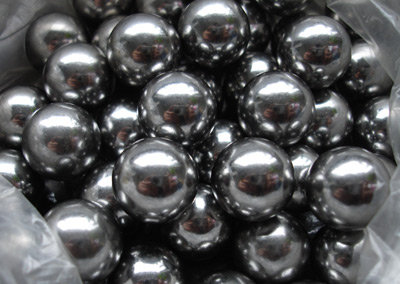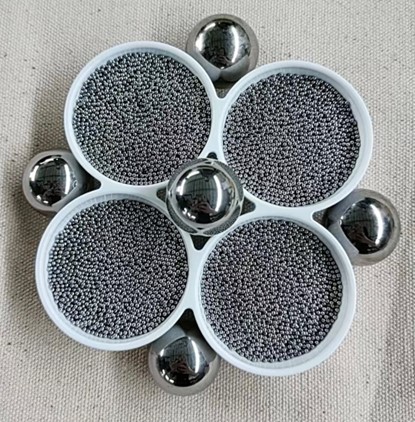|
|
|
Products
stainless steel ball |
|
|
| Product name’╝Üstainless steel ball |
| Item’╝Ü |
| Details’╝Ü |
Stainless Steel Balls, Inox Steel Ball
AISI 304, 316, 302, 304L, 316L
|
| The most common grades of stainless steel balls are: |
| AISI / SAE / SUS 304. The most commonly specified austenitic (chromium-nickel stainless class) stainless steel, which accounts for more than half of the stainless steel produced in the world. This grade withstands ordinary corrosion, is durable and resists most chemicals. |
| AISI / SAE / SUS 316. Austenitic (chromium-nickel stainless class) stainless steel containing 2%-3% molybdenum (whereas 304 has none). The inclusion of molybdenum gives 316 greater resistance to various forms of deterioration. |
| AISI / SAE / SUS 302. Has almost the same chemical composition as 304 with slightly more carbon content and less chromium. Corrosion resistance is less than 304. |
Properties
ŌŚÅ Corrosion Resistance: AISI 316 > 304 > 302.
ŌŚÅ Hardenability: The above stainless steel are not hardenable by heat treatment. Some work-hardening takes place on balls during cold-forging.
ŌŚÅ Magnetism: AISI 304 and aisi 302 are slightly magnetic and AISI 316 is non magnetic. However, in the manufacture of steel balls and media during cold forging / heading, slight magnetism is induced in all the stainless steel types.
ŌŚÅ Passivation: The stainless steel balls are passivated after final polish. Carryover iron and other contaminants are removed and a surface film prevents atmospheric and water corrosion.
|
Austenitic Stainless Steel Balls
The largest category of stainless steel, accounting for about 70% of all production.
The austenitic class offers the most resistance to corrosion in the stainless group because of its substantial nickel content (8%) and higher levels of chromium(18%).
Austenitic stainless steels are hardened and strengthened through cold working (changing the structure and shape of steel by applying stress at low temperature); they are unhardenable by heat treatment.
Ductility (ability to change shape without fracture) is exceptional for the austenitic stainless steels. |
| |
Carbon
C |
Manganese
Mn |
Silicon
Si |
Phosphorus
P |
Sulphur
S |
Nickel
Ni |
Chromium
Cr |
Molybdenum
Mo |
AISI
302 |
0.15 max |
2.00 max |
1.00 max |
0.045 max |
0.03 max |
8.0-10.0 |
17-19 |
Nil |
AISI
304 |
0.08 max |
2.00 max |
1.00 max |
0.045 max |
0.03 max |
8.0 -10.5 |
18-20 |
Nil |
AISI
304L |
0.03 max |
2.00 max |
1.00 max |
0.045 max |
0.03 max |
8.0 -10.5 |
18-20 |
Nil |
AISI
316 |
0.08 max |
2.00 max |
1.00 max |
0.045 max |
0.03 max |
10-14 |
16-18 |
2-3 |
AISI
316L |
0.03 max |
2.00 max |
1.00 max |
0.045 max |
0.03 max |
10-14 |
16-18 |
2-3 |
Effects of Alloying Elements in Stainless Steel Balls
Alloying Element: Any metallic element added during the making of steel for the purpose of increasing corrosion resistance, hardness or strength. The metals used most commonly as alloying elements in stainless steel include chromium, nickel and molybdenum.
The Basics
Steel is a combination of iron and carbon. In its softened state, the base is a matrix composed of simple iron molecules (ferrite), in which are suspended molecules of iron carbide (cementite). When steel is heated to prescribed temperatures, then cooled at a specific rate, it undergoes physical internal changes which manifest themselves in the form of various micro-structures such as pearlite, bainite, and martensite. These micro-structures (and others) provide a wide range of mechanical properties, making steel an extremely versatile metal. |
Carbon
The presence of carbon in iron is necessary to make steel. Carbon is essential to the formation of cementite (as well as other carbides), and to the formation of pearlite, spheroidite, bainite, and iron-carbon martensite. The hardness of steel (or more accurately, the hardenability) is increased by the addition of more carbon, up to about 0.65 percent. Wear resistance can be increased in amounts up to about 1.5 percent. Beyond this amount, increases of carbon reduce toughness and increase brittleness.
Silicon
Silicon is used as a deoxidizer in the manufacture of steel. It slightly increases the strength of ferrite, and when used in conjunction with other alloys can help increase the toughness and hardness penetration of steel.
Manganese
Manganese slightly increases the strength of ferrite, and also increases the hardness penetration of steel.
|
Chromium
Chromium (Cr) has a tendency to increase hardness penetration. Chromium can also increase the toughness and wear resistance of steel. Probably one of the most well known effects of chromium on steel is the tendency to resist staining and corrosion. Steels with 12% or more chromium are referred to as stainless steels.
Nickel
Nickel (Ni) increases the strength of ferrite and hence of steel. It is used in low alloy steels to increase toughness and hardenability. Nickel also tends to help reduce distortion and cracking during the quenching phase of heat treatment. Nickel provides high degrees of ductility as well as resistance to corrosion.
Molybdenum
Increases the hardness penetration and high temperature tensile strength. In the presence of chromium enhances the corrosion resistance of stainless steel. |
|
|
 |
ŌåÉ[Previous’╝Ü]
|
|












